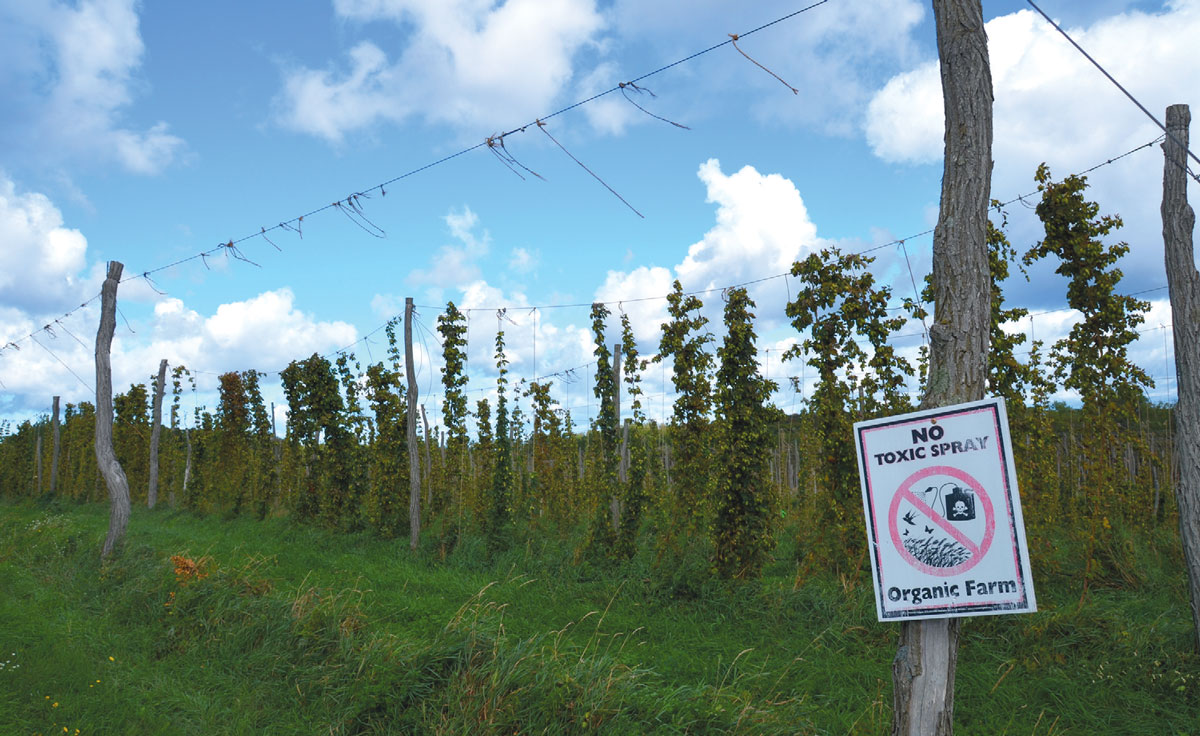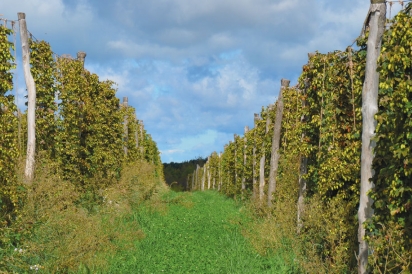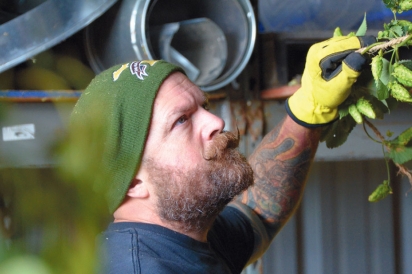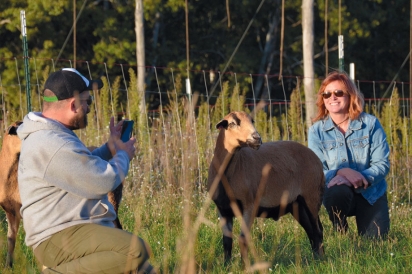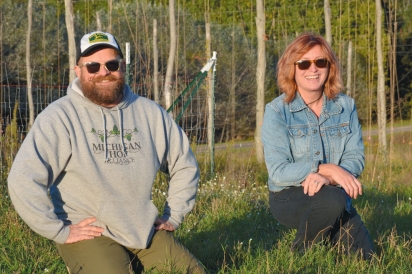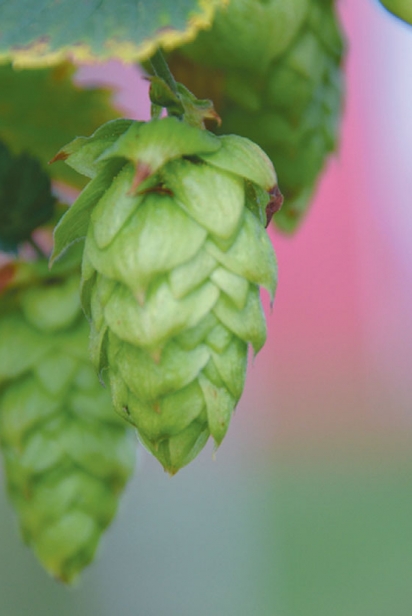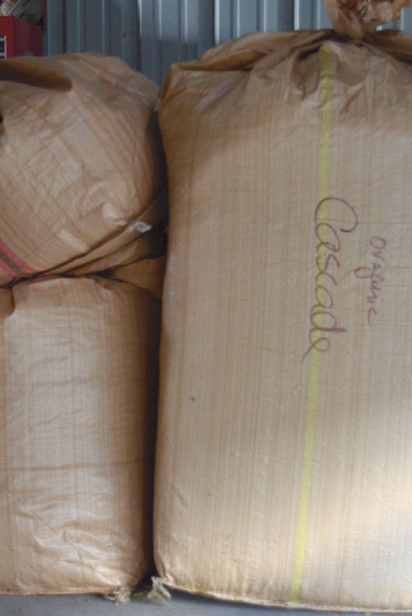New Mission Organics
Growing Hops and Growing a Farm
I am sitting in a camp chair next to Brian and Amy Tennis, owners of the New Mission Organics hop farm. Before us, the door of the processing barn is wide open to the lateafternoon sun, and an impressive German-made hop stripper stands at our backs. Brian pours me a tall glass of Nice, a dark ale made by Bang Brewing in St. Paul, MN—one of the many microbrewers using New Mission hops. As I sip the delicious brown nectar, Brian and Amy chat with me about the business of growing hops.
New Mission Organics is located just outside the village of Omena in northern Leelanau County. The Tennises first planted hops on this relatively flat patch of land about five years ago, making them among the first commercial hop growers in the past 100 years of Michigan’s history. In the short time since, they have become key members of the fledgling ranks of Michigan hop growers. Founders of the Michigan Hop Alliance, they are partnering with other local growers, as well as many of the best brewers in the state and beyond, to grow, harvest and process hops.
“I don’t think we ever really had a dream to grow hops. We fell into it,” Amy tells me. “We came up from Grand Rapids to vacation. Picked up some real-estate brochures and came across a 10-acre parcel of cherry trees slated for development. We bought it in 2006 to have a place to set up our tent and spend weekends.”
As new owners of an orchard, the Tennises set out to learn how to take care of it—including how to drive a tractor—and for a few years harvested their cherries and sold them at the Fulton Street Farmers’ Market in Grand Rapids.
“We should have listened to Jim Bardenhagen from MSU Extension,” Brian interjects. “Early on, when we asked for his advice, he suggested we rip out the cherries. You can’t make any money on 10 or even 20 acres of cherries. Instead, in 2009 we bought another 10 acres of cherries.”
THE ROAD TO A NEW CROP
Firmly committed to being farmers, even if only in their spare time, Brian and Amy started to seek a more promising crop. Hops came to their attention via new classes on hop growing taught by agro-ecologist and hop expert Rob Sirrine. Sirrine and his colleagues at MSU Extension had been looking for new crop options for the farmers they advised. In 2008, when an international hop shortage put brewers in a panic and pushed the price of microbrews to new heights, Sirrine’s group began looking into hops. They found that specifications for the ideal hop-growing conditions—location between the 35th and 50th parallels; soils with good drainage; plenty of water; long summer days; cold winters—were remarkably similar to conditions in their region.
Buoyed by their findings, Sirrine and MSU Extension started offering courses in hop growing to Michigan farmers wanting to convert less-profitable crops or start from scratch with a crop that might favor the eager beginner. At the same time, they initiated research into hop varieties that would be resistant to downy mildew and would thrive in the soil and weather conditions of Northern Michigan.
For the beer-loving Tennises, it was a perfect recipe of timing and passion. What better crop to grow than one that’s an essential ingredient of your favorite beverage?
“We’ve always been beer fans. Even when we were poor, we drank good beer. We’d covet Samuel Smith, Bell’s. We just didn’t drink as much of it.” Amy laughs as she remembers the time BH: Before Hops.
In 2009, fresh from their first introductory course on hops, the Tennises took the plunge, put up trellises and planted an acre. In 2010 came the chance to purchase acreage that MSU, the USDA, the University of Vermont and the University of Washington had planted as a research site to test 20 hop varieties. Brian and Amy joined in the research experiments, expanding their knowledge base and working alongside experienced colleagues in this small yet growing field. In 2012 they picked up another 10 acres from a failed housing development in Omena, and with the blessing of the Leelanau County Planning Commission and the Leelanau Conservancy, converted it back to farmland.
“We’ve been upping the acreage every year,” Amy says. “Whatever we earn from the hops is ploughed right back into the farm. We now have 10 acres in hops, and we’re going to double it (we hope) this next year. We’ve found local backers to work with us on the expansion and to help us purchase better equipment, bigger picking machines.”
IN A GROWING REGIONAL MARKET
Though this may have started as a hobby for Brian and Amy (they say they were “putzing along, an acre or two at a time”), the fact that there are now 200 acres of hops planted down the road in Williamsburg, with plans for 200 more, has pushed them to re-draft their business plan. Now the Tennises intend to grow, yet remain a resource for a diverse selection of great hops that grow well in the Leelanau terroir. Some are proprietary—they pay a royalty fee for the exclusive regional right to grow certain varieties, like the semidwarf Summit—and some are simply unusual to please the creative brewer. On the horizon are varieties from New Zealand, France, Japan and Kazakhstan.
Looking back, Amy says they knew they were on the right path when, two years ago, they surmounted a key hurdle: their hop production was sufficient to cover the cost of labor and inputs. This was both cause for celebration and an indication that they were on the way up. The plants would yield more, and most of their learning curve was in the rearview mirror.
The key, according to Amy, is vertical integration. Having observed the Leelanau County cherry growers and their system of bringing all their cherries to a central processor, Amy and Brian opted for a different business model. They not only grow the hops, but also pick them, process them and sell the finished product: dehydrated hops that are pelletized by a proprietary method and chilled. In this model, economy of scale is important. Investing in equipment is expensive: harvest machines run from $50,000 for a used or refurbished machine to more than $300,000 for a new one. However, once on site, the machine can process a lot of product. If you can process one acre, you can process 10 or more. The quality and size of the equipment is key.
Brian tells me that his refurbished picker cost roughly $50,000. Under their plans for expansion, the Tennises are looking to either acquire a new one with greater capacity, or to add two used Wolf pickers, as well as a “top cutter” harvesting wagon and a second dryer. The dryers come from Germany and cost about $25,000 each, used.
EXPLORING SUSTAINABLE PATHS
In their evolution from weekend gardeners to professional hop farmers, the Tennises’ self-guided education has taken them to Germany, New Zealand and Washington State to meet colleagues and learn new techniques. Their hop fields abound with the fruit of their learning and curiosity: sheep and alpacas nibble at the lower leaves, which helps keep down weeds and downy mildew (they plan on expanding their sheep herd from the current 20 to 100 head, or 10 sheep per acre). Quantities of “beneficials”—ladybugs, lacewings and predatory mites—are released yearly to combat parasites. Both short and tall trellises have been installed to expand the harvest potential; naturally sturdy, rot-resistant black locust wood is used for the posts. Furthermore, the results of that 20-variety research experiment led to the planting of nine new varieties that have local and international brewers clamoring for more.
When the Tennises first took over the original cherry orchard, they managed the trees organically and followed with certification. They brought these practices over to their hop plantings—hence their farm name, New Mission Organics. While their current plantings are certified organic, Brian and Amy do not plan to certify the new acreage. There are several reasons behind this decision. For one, there are very few organic brewers, and thus few who are willing to pay the extra cost for organic hops. While high-quality conventionally grown hops sell for $10–$12 per pound, growers must ask $16–$18 per pound for organic hops if they are to make a profit. Furthermore, the yield of an organic hop field is, on average, between 60% and 70% of that of a conventionally grown field. Much of the loss is due to downy mildew, which in the organic world is treated with one topical product: copper sulfate, the famous Bordeaux mixture used by wineries and orchardists everywhere. Though approved for organic agriculture, this compound has some drawbacks—chief among them, for the Tennises, the fact that it is toxic to the sheep that serve as their weed brigade.
Thus, as they move forward with the projected expansion, the Tennises are looking to continue the sustainable agricultural practices they’ve learned along the way. Forgoing certification makes it possible for them to combat downy mildew with products to that are not on the National Organic Practices (NOP) list of options.
“We’re taking the lead from Larry Mawby. He’s one of my heroes,” says Brian. “We want to be as green as possible and yet also do what is truly sustainable, which means taking care of the land and our bank account.”
GOING GLOBAL
The Tennises are aware that, even though their farm is in the out-of-the-way pinky of Leelanau County, their market is global. Up to this point, most of their harvest has been sold to Michigan brewers. But they’re not going to stop there. The most recent figures put the United States at 39% of the world hop market—Germany is the top producer at 44%. Even with hop plantings increasing nationally, the demand from microbrewers is more than keeping pace. Since the Tennises started growing hops, the number of microbreweries in Michigan alone has risen from 100 to the more than 168 currently listed on the members’ page of the Michigan Brewers Guild. In 2015, just under 40,000 acres of hops were planted in the United States, the vast majority on large farms in Washington, Oregon and Idaho. Approximately 600 acres are planted in Michigan at this time. With the drought conditions affecting much of the West Coast, Michigan growers are well positioned to increase their market share.
Internationally, American microbrews are noted for their hoppy flavors and the unique notes that the locally grown hops permit. The hop farms across the nation have a unique terroir and different growing styles. According to Andy Largent of the Filling Station microbrewery in Traverse City, Michigan hops tend to be more earthy and spicy than West Coast hops. Brewers from as far away as Norway, Finland and Japan have all shown interest in purchasing the Tennises’ hops.
What makes the international (and crosscontinental) market possible is the successful processing of hops from fresh cones to dehydrated pellets. To this end, Rob Sirrine and his colleagues at MSU Extension have been focusing their research efforts not only on new hop varieties, but also on improving the post-harvest drying and curing process.
The cones are dehydrated with a hot-air furnace to reduce their moisture content to between 8% and 10%. They are then baled and placed into cold storage. Once the harvest and drying are completed, the next step is to pelletize the hops and bag them in Mylar, using a nitrogen purge to remove oxygen. Finally, they are chilled to the industry standard of 28°–32° F, at which point they can be stored or shipped.
The quality is very stable; they retain their full flavor for up to four years. However, New Mission Organics’ hops are not sitting around that long. In nine months, this year’s harvest will have disappeared, transformed into some of your favorite microbrews at Short’s Brewing Company, Grand Rapids Brewing Company, Griffin Claw Brewing Company, the Filling Station, Osgood Brewing, Pike 51 Brewery, Rare Bird Brewpub, Unity Vibration, Farmington Brewing Company, Final Gravity Brewing Company, Greenbush Brewing Company, Mackinaw Brewing Company, Starving Artist Brewing Company, Northport Brewing, Hop Lot Brewing Company, Stormcloud Brewing Company and Brewery Vivant (for whom they’ll be planting a special French variety this upcoming year).
Weary from the recent harvest, Brian confides to me: They’ve never made a backup plan. But, flushed with joy to be at the finishing line of another growing season, they seem happy with how far they’ve come and ready for what lies ahead.
Tasting notes for New Mission Organics Hops
Centennial: Medium intensity, with floral and citrus (lemon) notes.
Galena: Spicy with currant and citrus (grapefruit) notes.
Summit: Earthy, strong orange and tangerine citrus notes, unique chives, lemon grass and garlic undertones. Not for everyone. Short’s Brewing uses Summit hops in its Spruce Pilsner and Bonafide Legit.
Cascade: Classic hop variety that is widely used by craft breweries. Medium-intense floral, citrus and grapefruit notes. Bee Well Meadery uses Cascade in their Hopped Honey dry-hopped honey wine.
Chinook: Favorite of Andy Largent at the Filling Station Microbrewery. Their Walla Walla IPA uses Chinook hops exclusively. These dual-purpose hops offer both bittering and aroma. Largent likes its subtle grapefruit, spicy and piney notes.
Pekko: Pineapple and citrus flavors. The Filling Station uses them for dryhopped IPAs and double IPAs. Their Overlook Double IPA is made with a blend of Pekko and Bravo hops.
HISTORICAL HOPS NOTES
Hops became an ingredient in beer during the colonization period of Victorian England. The sailors of the British Royal Navy received a ration of a gallon of beer a day when at sea. However, the beer was spoiling on the long voyage around the Cape of Good Hope from England to India, causing a national emergency. Experimenting with various recipes and preserving techniques, the brewers of the day discovered hops, which both preserved the beverage and added bitterness. The India Pale Ale (IPA) designation emerged from this period.
Michigan was a popular hop-growing region at the time of the Civil War. When the plants suffered from an infestation of the hop louse, however, they were ripped out and replaced with other crops. There’s little mention of them after the 1900 agricultural census.


